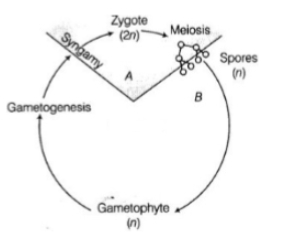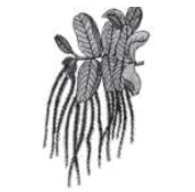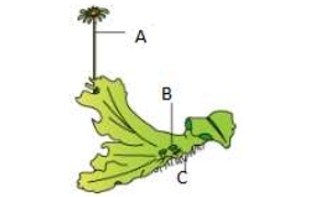The endomembrane system of a eukaryotic cell includes all except:
1. Vacuoles
2. Lysosomes
3. Peroxisomes
4. Golgi complex
Asexaul reproduction by pear shaped biflagellate zoospores is seen in most:
| 1. | Green algae | 2. | Brown algae |
| 3. | Red algae |
4. | Both (2) and (3) |
All the following pteriodophytes belong to the Class Pteropsida except:
1. Dryopteris
2. Pteris
3. Selaginella
4. Adiantum
Sexual reproduction by non-flagellated but similar in size gametes is seen in:
1. Chlamydomanas
2. Volvox
3. Spirogyra
4. Fuccus
In mosses, the sex organs are seen in:
1. Protonema stage
2. Leafy stage
3. Capsule of the sporophyte
4. Seta of the sporophyte
The features seen in the gymnosperm Cycas include:
| I. | Coralloid roots |
| II. | Unbranched stems |
| III. | Pinnate persistent leaves |
| IV. | Male cones and megasporophyllys borne on same plant |
1. I and II only
2. I and IV only
3. I, II and III only
4. I, II, III and IV
Both bryophytes and pteridophytes:
(1) are vascular cryptogams
(2) have a dominant sporophyte
(3) reproduce only sexually
(4) are haplo-diplontic
The life cycle pattern shown in the given diagram is not see in:

1. Chlamydomanas
2. Spirogyra
3. Volvox
4. Ectocarpus
The given diagram shows:

| 1. | An alga that lacks flagellated cells |
| 2. | A liverwort |
| 3. | A heterosporous pteridophyte |
| 4. | A gymnosperm with non motile sperms |
Identify the statement that most accurately describes the plant shown in the given figure:

1. This the male prothallus of Marchanita; A is antheridiophore and B is Gemma cup
2. This the female prothallus of Marchanita; A is archegoniophore and B is Gemma cup
3. This the male prothallus of Sphagnum; A is antheridiophore and B is Gemma cup
4. This the female prothallus of Sphagnum; A is archegoniophore and B is Gemma cup






